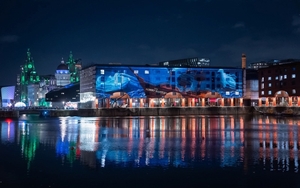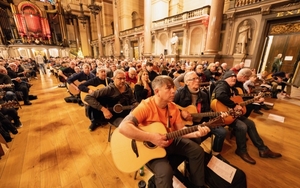ONE of Liverpool’s most esteemed urban planning experts has slammed proposals for a new-look Lime Street describing them as “walking all over the dead of Liverpool and stomping all over our memories”.
Dr Robert MacDonald, reader in architecture at John Moores University, entered the fray after Neptune Developments showed off its bland vision for one of the city’s most important streets.
As revealed by Liverpool Confidential in January, a gigantic block of student apartments takes up most of the street, replacing the (demolished) Futurist and Scala cinemas and bookended by the two pubs, The Vines and The Crown.
In a slight tweak to the original drawings, the Futurist sign is retained, sitting above a new retail unit. Campaigners who were assured back in January that the facade would be retained, may well see the sketch as adding insult to injury.

Spot what's left of the Futurist, looking not unlike the architectural equivalent of the Stonehenge model in Spinal Tap
Dr MacDonald, who is a member of the Royal Institute of British Architects and a recipient of a Roscoe Citizenship Award, summed up his views of the current controversial plans by Liverpool City Council’s preferred developer.
“This district is a real Liverpool cultural quarter,” he said. “The proposed architecture swamps and overshadows Lime Street. The Crown is squeezed out of the picture. The proposed brown slab is even worst than the old grey monster of Skelhorne Street.
“Lime Street, along with all the Liverpool cinemas, brought Hollywood musicals and westerns to Liverpool,” he went on. “Later Alan Rudkin, the world boxing champion, owned The Vines (Big House ) and The Liverpool Boxers Association met in the Irish American Bar. The Crown is a remaining class act as a Liverpool public house. This project is walking all
over the dead of Liverpool and stomping all over our memories.”
Dr MacDonald said presenting the scheme with just Photoshopped images is unacceptable and called for an urban design forum and a master plan of 3D models which would be available for public scrutiny.
He added: “These buildings are supposed to be gateways and say welcome to Liverpool. The Photoshop drawings are an illusion, physical models would be better to show the facades, spaces and proposed materials. We need proper models for open and transparent scrutiny. Massing, scale, proportion and fenestration all need to be carefully investigated.”
Dr MacDonald suggests the whole Lime Street district needs an urban design master plan which should be scrutinised by a Public Design Forum.
“Liverpool City Council should commission a physical model so that all the connections can be reviewed.
In most European cities, Barcelona, Amsterdam, Berlin, there are public design forums .
“There used to be a 1.500 scale block model of the city which showed new proposals. Are Liverpool City Council Planning Department and the Mayor aware of these kinds of models?
“Liverpool One had a very effective large scale model and that project involved an urban design master plan and about 25 different architects. I don't think anybody in Liverpool would doubt the international success of architecture and urban design there. Public engagement and participation was important. It seems these lessons have been forgotten around Lime Street.”

Dr MacDonald said he would welcome the restoration of LUDCAP, a one-time body of architects, academics and town planners who met regularly – with no pay or fees involved – to give the once over to major plans in the city. The panel had no statutory powers, but it could give suggestions and opinions as a way or driving up higher standards of architecture and design.
Even Mayor Anderson has been critical of Neptune’s latest offering for Lime Street which would most of it reduced to rubble.
Campaigners have called for at least the stunning frontage of the Futurist to be preserved, but Regeneration Cabinet Member Malcolm Kennedy says it can’t be afforded as it would add several millions to the cost of creating a new-look Lime Street.
Others may argue it is a price that must be paid in order to protect and preserve a street whose name is known across the world.















